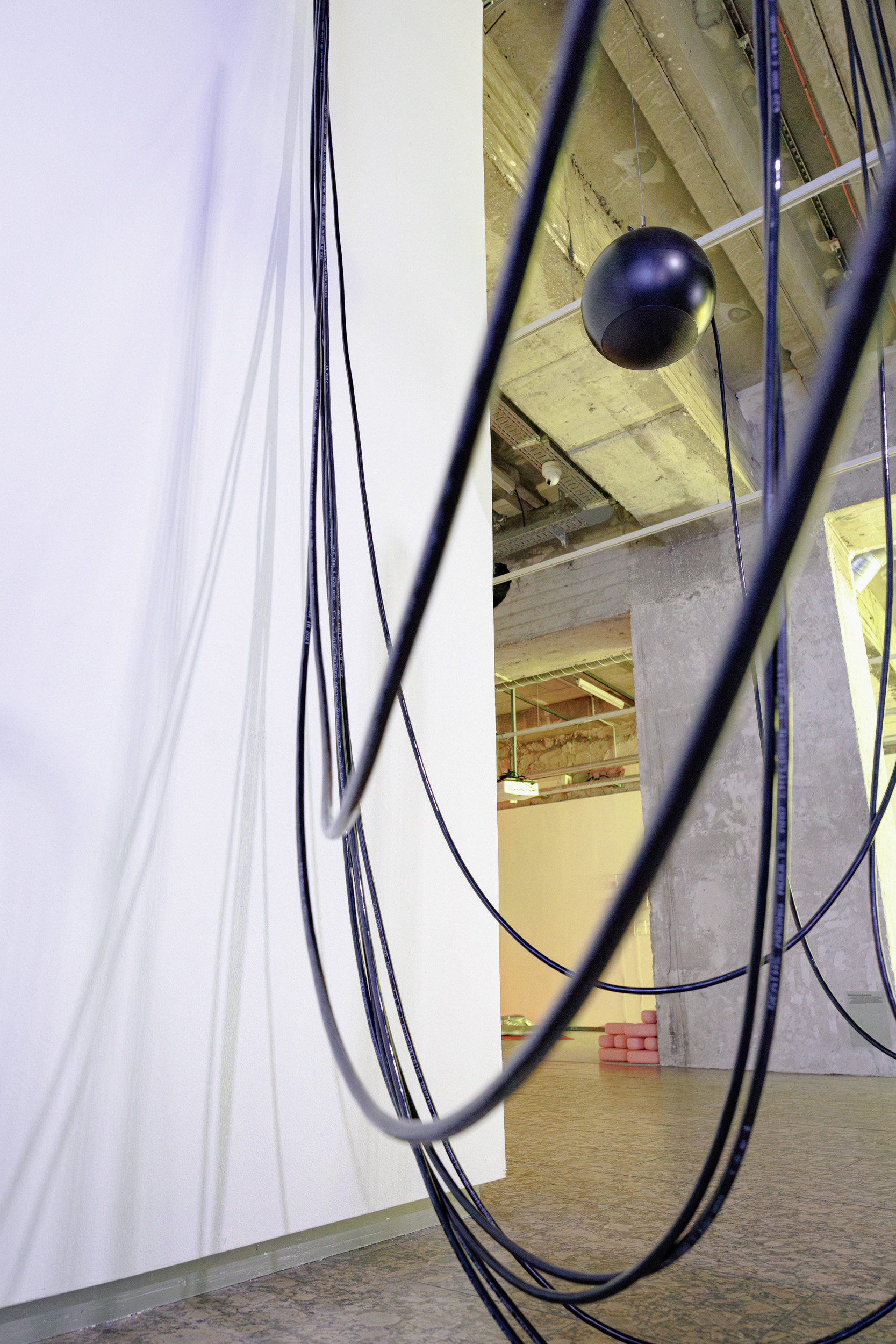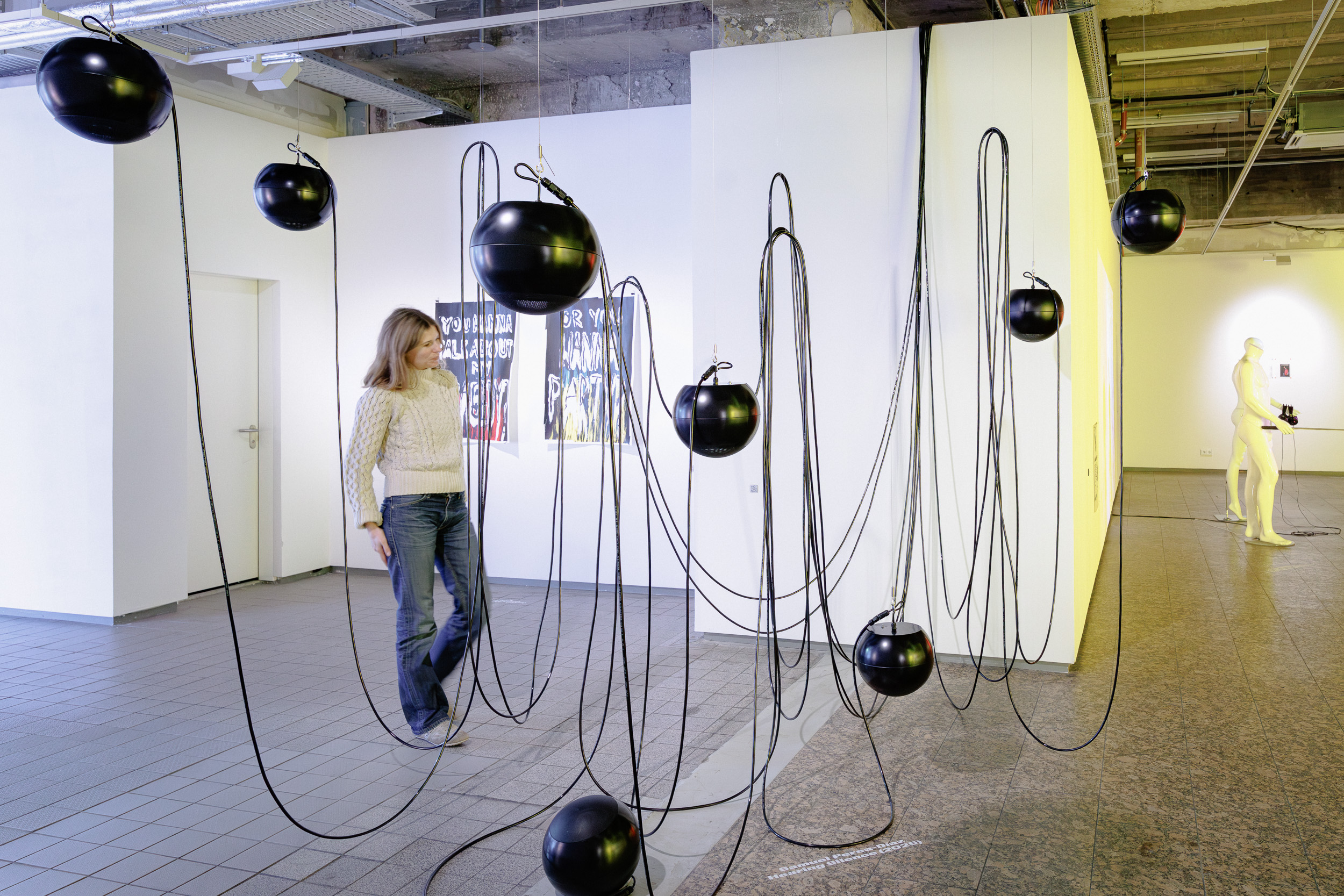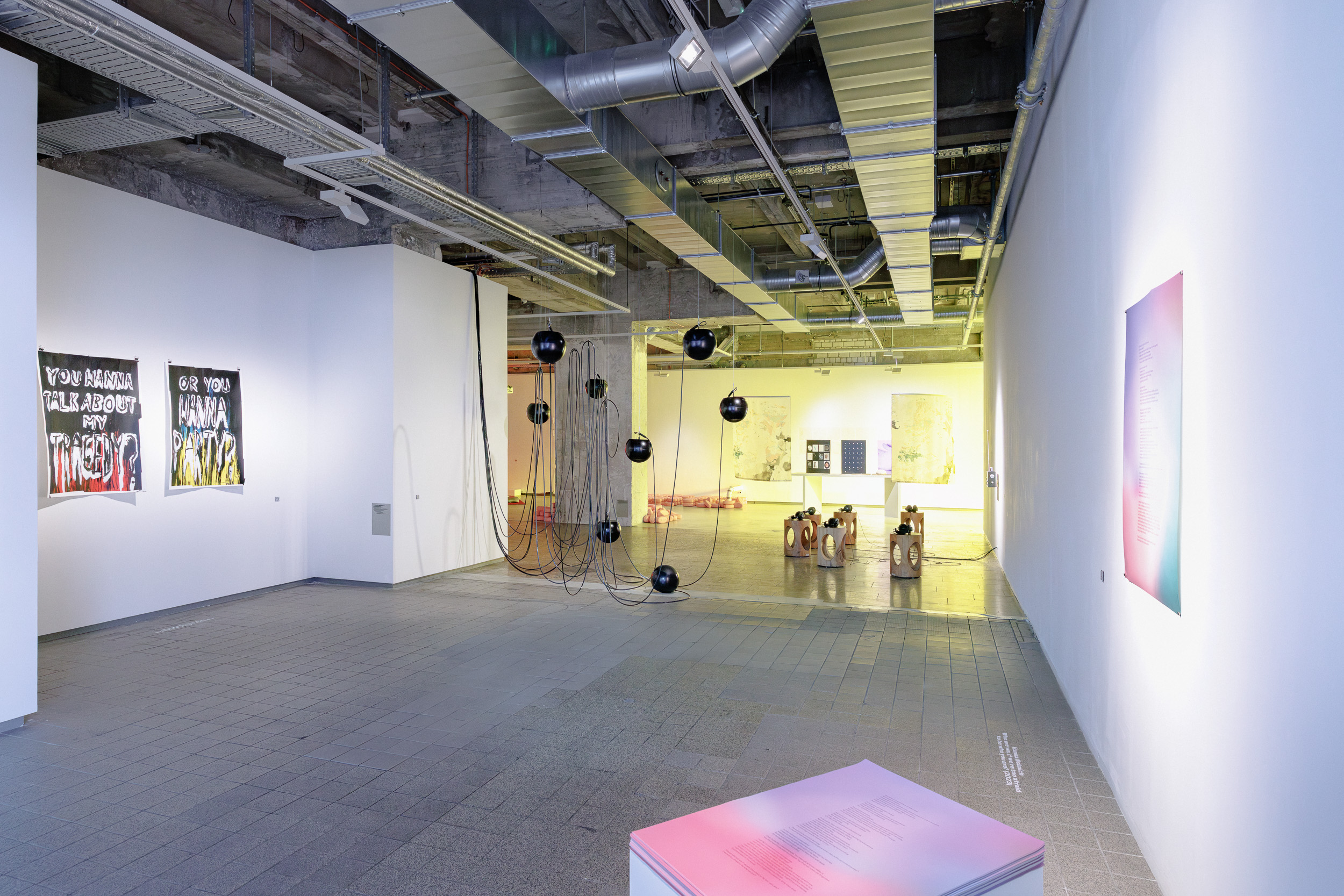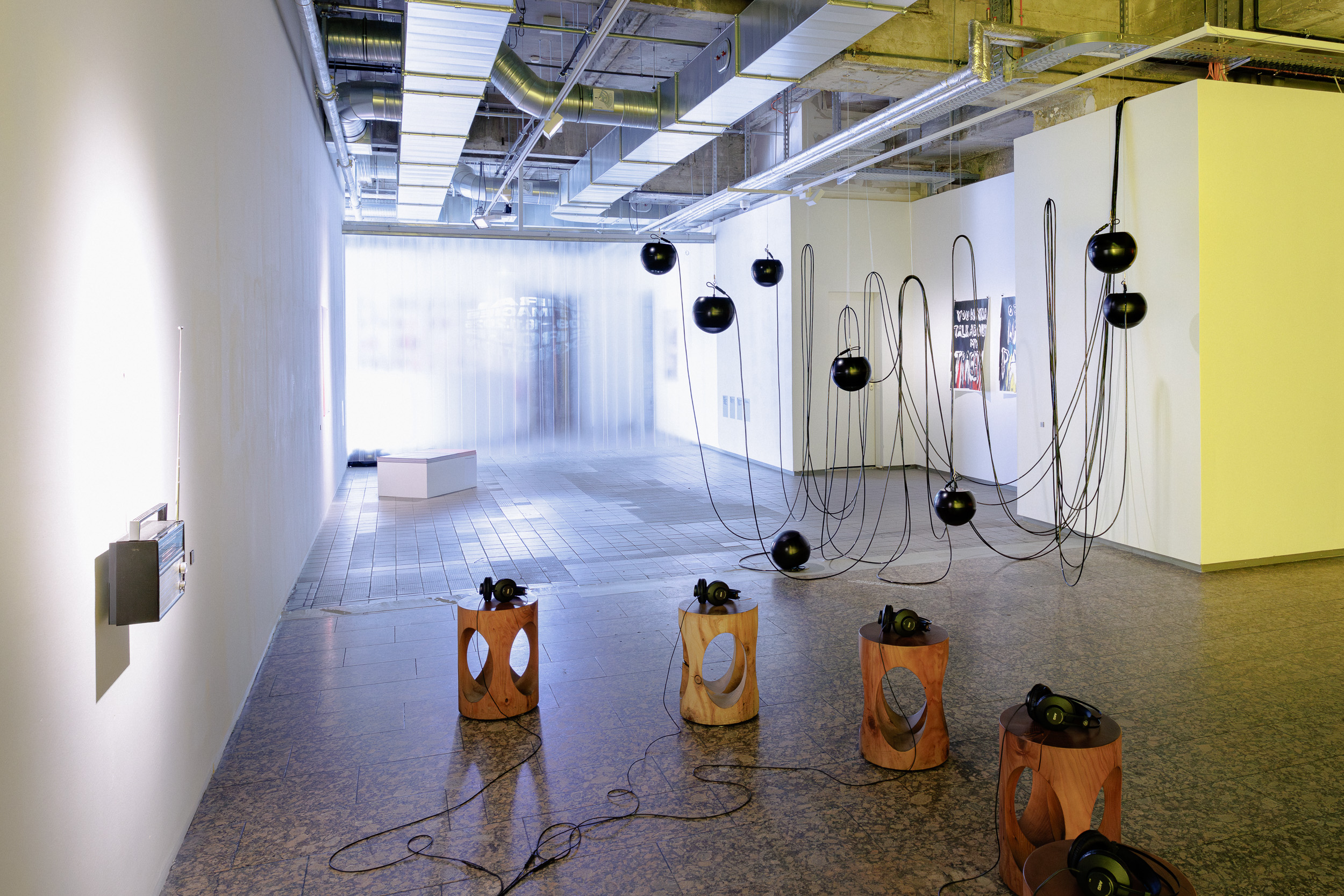









 📷 Patricia Sevilla Ciordia
📷 Patricia Sevilla Ciordia








📷
Jörg DederingSound Installation
Hearing Silence
Material:
multichannel installation with 8 speakers, amplifiers, cables and sound. Variable dimension.
Hearing Silence is a generative sound installation that engages the possibilities of listening through the sonification of AIDS-related death statistics. Developed as part of a broader artistic research project on sound and the HIV/AIDS epidemic, the work articulates the tension between presence and absence, sound and silence. The installation challenges audiences to witness AIDS-mortality data by ear, displaying sonic impulses at the limit of human hearing.
For the exhibition, the artist is presenting “Hearing Silence”, a cluster of speakers draws from a previous one-channel sound work entitled “UNAIDS_FactSheet_en.pdf”. This the work is presented as a multichannel set up. Each speaker generates impulses of a 20kHz sine wave, displaying the pulse rate of worldwide deaths from AIDS-related causes in different years. The piece sonifies the most recent statistics from UNAIDS, the world's most extensive data collection on the HIV epidemic.
In Hearing Silence, each death is rendered as a near-inaudible acoustic event—a burst of a 20kHz sine wave—calculated to occur at intervals matching the temporal frequency of these losses. Each monitor is archiving a different year, for exaxmple the most recent data set is using the 2024 figure of 630,000 deaths per year, the average interval between pulses in a year is about 50.1 seconds. The result is a soundscape of silence and near-silence that quietly underscores the scale of global suffering. The 20kHz frequency lies at the threshold of human hearing—technically audible but often imperceptible to most listeners.
Data sonification reveals that the average interval between pulses has been increasing over time, reflecting a changing but still persistent pattern of loss. Despite its minimal aesthetic and near-invisibility, Hearing Silence is charged with urgency and historical memory. It references the sonic activism of groups like ACT UP, which used auditory interventions and number—such as air horns or chants and numbers in banner—to give sound to lives lost and demand attention from the state and medical institutions. In contrast, this work retreats into silence, asking us to listen to what is not immediately there. The sine wave becomes a spectral marker, a sonic trace of those not always counted or remembered.
The work embodies what could be termed a “volume of silence”—a space where sound exists beyond human perception, yet is measurable, real, and loaded with meaning. This inaudible sound field reflects the structural silences surrounding HIV/AIDS, particularly in regions still criminalizing queerness or lacking access to antiretroviral medication.
Credits:
Tech/Max Patch: Eagle Wu
Production help: Patrick Rüegg
Comissioned for nGbK with the financial support of la Caixa Foundation and PICE, in the context of the doctoral studies at the Complutense University of Madrid
*********************************************
(español)
Título de la pieza
Escuchando el Silencio
Material:
Instalación multicanal con 8 altavoces, amplificadores, cables y sonido. Dimensión variable.
Escuchando el Silencio es una instalación sonora generativa que explora las posibilidades de la escucha a través de la sonificación de las estadísticas de muertes relacionadas con el SIDA. La obra articula la tensión entre presencia y ausencia, sonido y silencio. La instalación desafía al público a experimentar los datos de mortalidad por SIDA a través del oído, manifestando impulsos sonoros al límite de la percepción humana.
Para la exposición Viral intimacies, el artista presenta un conjunto de altavoces que se basa en un trabajo sonoro previo, de un solo canal titulado UNAIDS_FactSheet_en.pdf. La obra se presenta aquí en una configuración multicanal, dondae cada altavoz genera impulsos de una onda sinusoidal de 20 kHz, mostrando la frecuencia de los fallecimientos por causas relacionadas con el SIDA en distintos años. La pieza sonifica las estadísticas más recientes de ONUSIDA, la colección de datos más extensa del mundo sobre la epidemia de VIH.
En Escuchanedo el Silencio, cada muerte se representa como un evento acústico casi inaudible: un impulso de una onda sinusoidal de 20 kHz. Cada altavoz contiene un año diferente; por ejemplo, el conjunto de datos más reciente utiliza la cifra de 2024 de 630.000 muertes por año, lo que genera un intervalo promedio entre pulsos de aproximadamente 50,1 segundos. El resultado es un paisaje sonoro de silencio y casi silencio que subraya de manera sutil la magnitud del sufrimiento global. La frecuencia de 20 kHz se encuentra en el umbral de la audición humana: técnicamente audible, pero a menudo imperceptible para la mayoría de los oyentes.
La sonificación de datos revela que el intervalo promedio entre pulsos ha ido aumentando con el tiempo, reflejando un patrón de pérdida cambiante pero aún persistente. A pesar de su estética mínima y su casi invisibilidad, la instalación está cargada de urgencia y memoria histórica. Hace referencia al activismo sonoro de grupos como ACT UP, que utilizaban intervenciones auditivas y números —como bocinas de aire o cantos y cifras en pancartas— para dar sonido a las vidas perdidas y exigir atención del Estado y las instituciones médicas. En contraste, esta obra se retira hacia el silencio, invitándonos a escuchar lo que no está presente de manera inmediata. La onda sinusoidal se convierte en un marcador espectral, un rastro sonoro de aquellos que no siempre son contados o recordados.
La obra encarna lo que podría llamarse un “volumen de silencio”: un espacio donde el sonido existe más allá de la percepción humana, pero es medible, real y cargado de significado. Este campo sonoro inaudible refleja los silencios estructurales que rodean al VIH/SIDA, especialmente en regiones que aún criminalizan la diversidad sexual o carecen de acceso a medicación antirretroviral.
Créditos:
Ayuda técnica/Max Patch: Eagle Wu
Ayuda de producción: Patrick Rüegg
Producido para nGbK con el apoyo financiero de la Fundación la Caixa y con la ayuda para la movilidad de artes visuales, Acción Cultural Española (AC/E), PICE 2025, en el contexto de la investigación artística teórica/práctica de estudios de doctorados en la Universidad Complutense de Madrid.